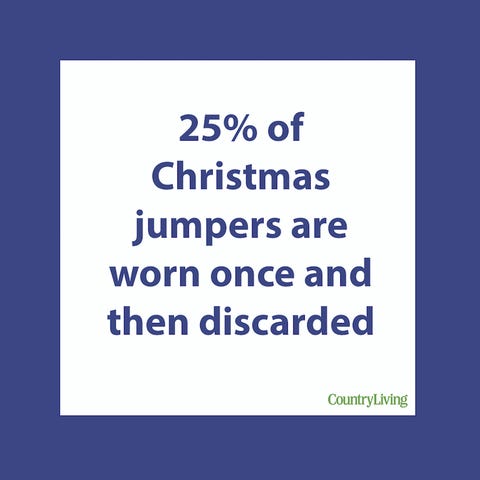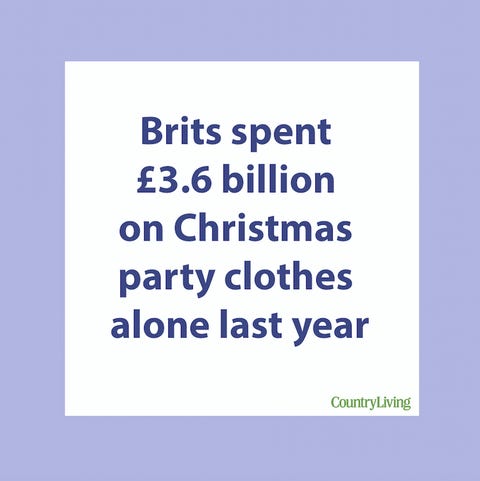How to Make Color Run Color Stay in Clothes
We earn a commission for products purchased through some links in this article.
With Christmas rapidly approaching, the need for festive party outfits and novelty jumpers is often high on our list of things to buy. But when the celebrations end, so does our need for the clothing — and sadly, they're often never worn again.
In fact, according to a previous study, Brits collectively spent £3.6 billion on Christmas party clothes alone last year, but eight million of these items were only worn once. In the research, conducted by Oxfam, it found that 18% of us admitted to buying at least five pairs of shoes for Christmas, while 65% said they would spend over £100 on something new simply for a family event or party.

Country Living
Likewise, Christmas jumpers are also often only worn once. Previous research found that one in three under-35s admitted to buying a new Christmas jumper every year, with 24% saying they didn't want to be seen in the same style as last year. Shockingly, Hubbub also found that Christmas jumpers are normally binned instead of donated.
So, what can we do differently this year to help the planet?
This content is imported from {embed-name}. You may be able to find the same content in another format, or you may be able to find more information, at their web site.
How do clothes swaps work?
Here at Country Living, we've been putting our best foot forward to try and live a sustainable life, both at home and in the office. Whether it's swapping our makeup routine to waste-free alternatives (find out how we got on here), or ditching wrapping paper for pretty fabrics instead, we're keen to do all we can to be kind to the planet — and that has also meant attempting to swap clothes, instead of buying them new.
Clothes swaps are often held in a community space or at someone's house. People will arrive with their pre-loved garments that they no longer wear and place them on a designated table. Afterwards, you will be given a token informing you of how many items you can take, or you'll be allowed to browse freely.

Country Living
Earlier this year, I attended my first locally-run clothes swap. At first, I was skeptical, unsure about exchanging clothes with a stranger. Were the clothes going to be clean? Would I be disappointed with my findings? Would I feel a similar rush of excitement that comes with buying clothes brand new?
This content is imported from {embed-name}. You may be able to find the same content in another format, or you may be able to find more information, at their web site.
But, after realising the carbon impact of the fashion industry, any doubts were overridden and I knew that swapping clothes was exactly something I should try. If not for me, then for the planet.
And? I loved it. Not only was it a brilliant social event but I left with practical shirts, a navy winter jumper (which I haven't stopped wearing), and a lovely blouse. Best of all, it cost me nothing but a donation upon arrival.

Country Living
If you want to host your own clothes swap, simply...
1. Get together with a group of friends and ask them to bring with them clothes and accessories they no longer need.
2. Once everyone has arrived, arrange the clothes around the room for people to easily 'shop.'
3. Then, once it's all ready, simply browse your favourites and try them on. As well as leaving with new items, you will have given your pre-loved clothing a new home.
The experts weigh in: Can clothes swaps actually make a difference?
Meg Lewis from Labour Behind the Label tells Country Living: "Clothes swaps promote care and respect for clothes, and in turn the labour and natural resources in manufacturing processes. If consumers become aware of the value in extending the life of garments, we can pressure brands to shift focus away from quantity of products towards quality."
Hannah Carter, campaign manager at Love Not Landfill says : "Clothes swaps are the ideal way to get 'new' clothes without contributing to climate change. Basing the clothes swap around occasions is perfect. For example, swaps focusing on party seasons, such as Halloween, Christmas and holiday wardrobes are all great ideas."
Olivia Dowie, CEO at sustainable clothing company Riley Studio says: "This is just one way we are able to prevent over-production and support a move towards a more circular economy. As a country, we have a big problem with over-consumption. We can all reduce the amount we buy, as well as begin thinking about where and how a product has been made. For example, buying a product that has been locally made reduces the carbon footprint."

Country Living
Cheap fashion with a high cost to humanity
Annually, the global textile industry emits a staggering 1.2 billion tonnes of greenhouse gases.
Passionate about campaigning for garment workers' rights across the world, Meg from Labour Behind the Label explains that the fashion industry needs to desperately devise a better, more sustainable model. She tells us: "The fast fashion model that we currently have where high quantities of clothes are produced for rock-bottom prices is not sustainable for either the planet or workers. It demands that garment workers work for excessive hours to reach impossible targets for poverty pay.
"Fashion needs to be slowed down in order to support higher wages and better living conditions for the people who make our clothes. Clothes swaps show an alternative way that we as consumers can value and extend the lifetime of the clothes that we wear."

Country Living

Country Living
But that's not all: there's a more fatal side of the fashion industry.
When 1,100 people died in the deadliest garment factory collapse in Bangladesh back in 2013, it highlighted the horrific true cost of fast fashion.
The morning of the disaster, workers begged their managers not to go in. Well aware of the dangers, their bosses forced them to continue working anyway — and it wasn't long before we witnessed a horrific mass industrial homicide.
After the disaster, pressure began to mount on high-street retailers as consumers stood up to challenge them on where their stock came from. Now, more than ever, we want to know where our clothes come from and who made them.
This content is imported from {embed-name}. You may be able to find the same content in another format, or you may be able to find more information, at their web site.
With many of the clothes available on the high street, it's the workers making them who pay the biggest cost of all. Unsafe working conditions, inhumanely low pay checks and long hours: they face their lives on a daily basis to ensure our shops are stacked with shiny new items. But some are now wanting to make a change.
Last year, fashion designer Stella McCartney explained how she felt the fashion industry was dangerously damaging the environment, and how she wanted to revolutionise what it was about. Likewise, global sports brand, Adidas, also announced it would be partnering with London-based start-up, Stuffstr, to launch a new take-back scheme for our unwanted garments.
It might be some time until we slow fashion right down, but by implementing change step-by-step, we can help to make a global difference.
So, instead of buying a new Christmas outfit this year, why not swap something you already have with a close friend? Not only will you save money but you'll be helping the planet too. We'll be giving it a go...
Like this article? Sign up to our newsletter to get more articles like this delivered straight to your inbox.
SIGN UP
How to Make Color Run Color Stay in Clothes
Source: https://www.countryliving.com/uk/homes-interiors/interiors/a29807462/clothes-swaps-christmas/
0 Response to "How to Make Color Run Color Stay in Clothes"
Post a Comment